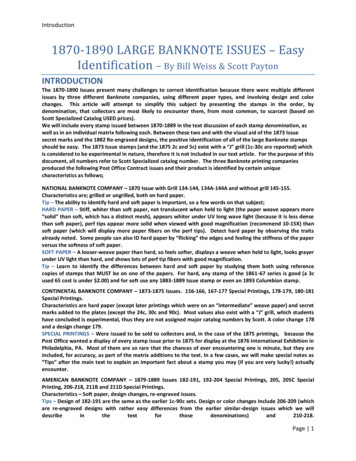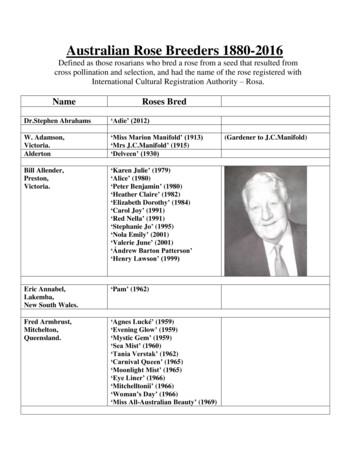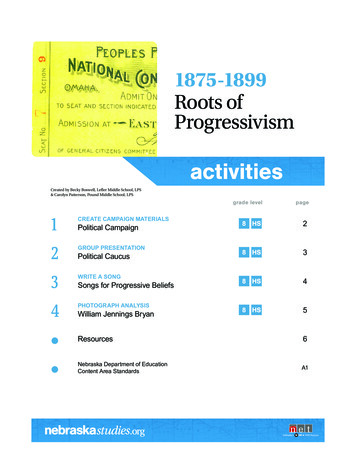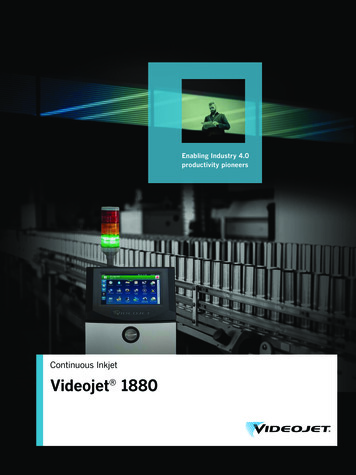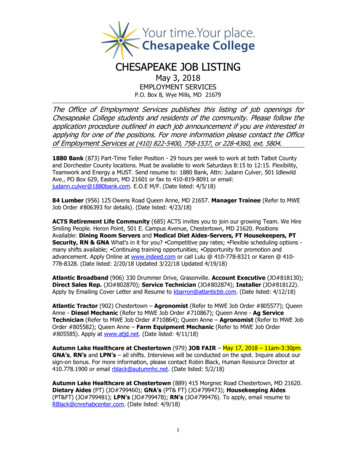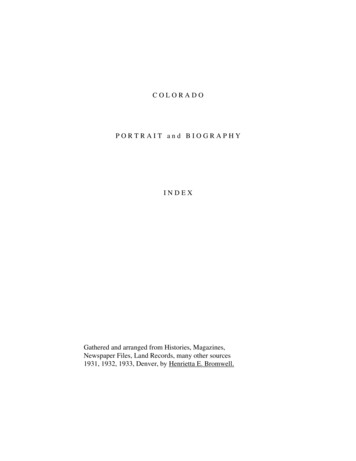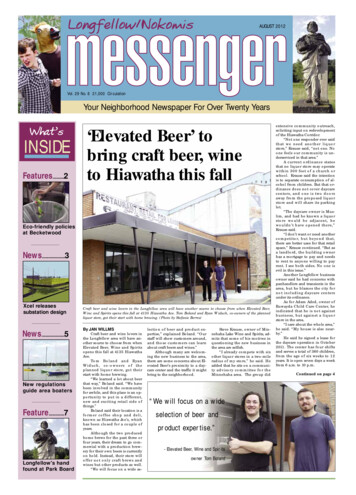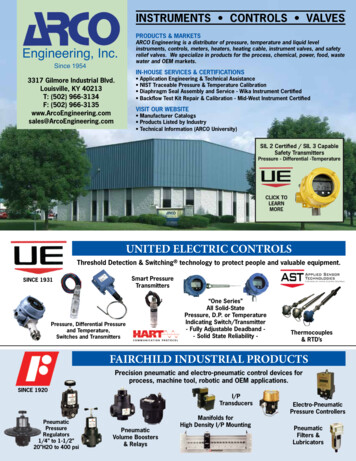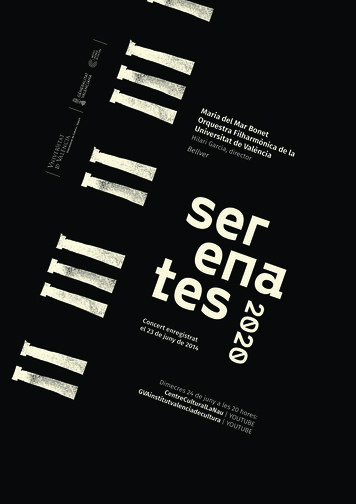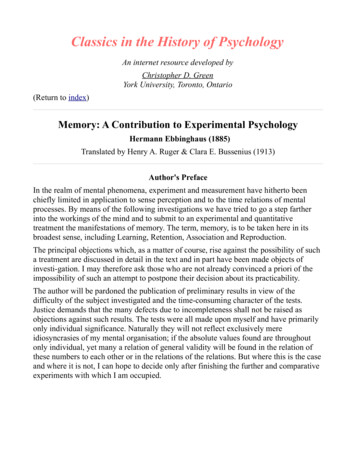
Transcription
FIGURE 10.1: Capitol at Night, by Clay Schulz, 20001861–65Civil War1860s1881874Silver boombegins in Montana18701866Montana Territoryholds first constitutionalconvention1879Edison patentslong-lasting light bulb18751878Butte Workingmen’sUnion formed1883Northern PacificRailroad completestranscontinentalroute188018851883Copper boombegins in Butte1884Montana Territoryholds secondconstitutionalconvention
ReAd To Find ouT:nWhy it took so long for Montanato become a statenHow the copper industry shapedMontana politicsnWhat the “War of the Copper Kings”was all aboutnHow ordinary people tried to regaincontrol over their stateThe Big PictureWhen Montana became a state, many different forcesfought one another for control of its rich resources.It was a constant challenge to keep Montana’sgovernment in the hands of the people.Gold lured the first prospectors to Montana, and silver attractedindustrialists, but it was copper that carried Montana’s economy intothe twentieth century. Electric motors, telephone and telegraph wires,and electric power lines all used copper. Some of the richest veinsof copper in the world lay under the Butte hill, and as the world’sdemand for copper soared, Butte’s mines expanded.Copper mining required enormous amounts of lumber, soMontana’s lumber industry developed right alongside the copper industry (see Chapter 12). Railroads built transportation networks tosupport these industries and also brought skilled labor into Montanato work in the mines, smelters, lumberyards, and cities (see Chapter9). The worldwide demand for copper brought growth, prosperity,and new opportunities—including the chance for Montana Territoryto become a state. But the rich resource also caused problems as conflicting interests competed for power.1889Montana adoptssecret ballot18901889Montana becomes a state1893Panic of 1893 andcollapse of thesilver market1900Marcus Daly dies1896Height of thePopulist movement18951894Voters choose Helenaas state capitol1899William A. Clark elected to U.S. Senatebut resigns amid bribery scandal1901Montana miners wineight-hour workday1902Montana state capitolbuilding completed19001906Heinze sells outto Amalgamated19051903Fair-trials bill passed1901William A. Clark electedto U.S. Senate19101910W. A. Clark sells outto Amalgamated4 — NEWCOMERS EXPLORE THE REGION18918 9
The Road to StatehoodEuro-American immigrants started pushing for statehood almost assoon as they arrived in the territory. They did not like living in a territory where they could not vote for their own governor. They did notlike that the federal government controlled the territory’s funds andappointed government leaders. And they wanted true representation inCongress. The territory’s congressional representative could lobby (tryto influence) congressmen and senators, but he could not vote.Once it became a state, Montana could control its own funds.Montanans could elect their own governor, judges, and state officers.Montana would gain one seat in the U.S. House of Representativesand two seats in the U.S. Senate. The state legislature (the branch ofgovernment that passes laws) could tax corporations, so that at leastsome money earned from Montana’s resources would stay to benefitMontana. And statehood came with a large land grant (free land thatthe federal government gives to a company, an organization, or a state)to help fund education.Montana’s Early Constitutional ConventionsFIGURE 10.2: These 45 delegates to the1884 constitutional convention wrote apopular state constitution, but Congressstill refused to grant statehood toMontana.19 0Even though a territory could not apply for statehood until its nonIndian population reached 60,000, citizens called Montana’s firstconstitutional convention (a meeting to write a constitution) in 1866.Having a constitution (a document that sets the rules for government) was an important step toward statehood. But at the time, fewerthan 20,000 non-Indians lived in theterritory. The 1866 constitution wasnot even presented to the people fora vote. It was too early for Montanato become a state.Montanans called their secondconstitutional convention in 1884.Citizens elected delegates (representatives of the people) to go to theconvention and draft a state constitution. Voters approved it by a hugemargin. But national politics got inthe way.That year Democrats controlledthe U.S. House of Representativesand Republicans controlled the U.S.Senate. House Democrats wanted toincrease their power by admittingterritories with mostly Democraticvoters—like Montana—into thePART 2: A CENTURY OF TRANSFORMATION
union. The Republican Senate wanted to admit only territories whosecitizens would vote Republican, like Washington and Dakota. For fiveyears neither side would allow the other’s territories to gain statehood.1889: Statehood at LastThe 1888 election swept a new group of politicians into Congress. Theyvoted to admit Montana, Washington, and North and South Dakota asstates. On February 25, 1889, President Grover Cleveland signed into lawa bill enabling (allowing) Montana to become a state. People called itthe Enabling Act. The next step was to write a constitution.Montana’s Constitution: Who Gets Control?In July 1889 Montana held a new constitutional convention to write aconstitution for Montana’s voters to ratify (formally approve). Seventyfive delegates gathered in Helena for the convention. They included mineowners, stockmen, farmers, merchants, real estate agents, and politicians.There were 39 Democrats and 36 Republicans.Two big fights arose during the convention. Both of them pitted themining interests (and related industries like railroads and lumber mills)against farmers and ranchers. By this time copper had grown into such animportant industry that the owners of large copper mines and smelters hadtremendous power. And they were used to getting what they wanted.FIGURE 10.3: Great Falls celebratedstatehood by printing satin ribbonswelcoming all four new states to theUnion: Washington, North Dakota,South Dakota, and Montana.How Should the Legislature Be Structured?The first fight erupted over representation to the state senate. Delegatesfrom sparsely populated eastern counties wanted each county to electone state senator no matter how many people lived in that county. Thiswould give rural counties more power.Delegates from the mining towns wanted representation in the senateto be based on population, as it was in the state house of representatives.This would give the heavily populated mining areas more power.As the debate raged on, Montanans realized how much the copperinterests wanted to control the legislature. Eventually, however, the mining interests gave in and agreed to the one-county–one-senator plan.They worried that voters would not ratify the constitution otherwise.Who Should Pay the Most Taxes?The second fight arose over taxes on mines. The mining industry insistedthat state taxes on mines should be especially low because mining wasso important to Montana’s economy. For most of Montana Territory’shistory, mines had paid very little in taxes—even though they yieldedmany more millions of dollars than ranching or any other industry.10 — POLITICS AND THE COPPER KINGS191
FIGURES 10.4 and 10.5: Who should paymore in corporate taxes to the state—themine owner who lives in this mansion orthe owner of this general store in Terry?Mine owner William A. Clark, whoowned the house pictured here, thoughthe should pay less in taxes than the Stithfamily, who owned the general store,because his business contributed moreto Montana’s economy.Mine owners wanted to write this special tax status into the constitution so that legislators could not change it later (because changingthe constitution requires a majority of all voters). This time the mininginterests refused to compromise. As a result Montana’s first state constitution called for mines to be taxed only on the value of the originalmining claim. Most original mining claims cost 5—even the ones thatproduced millions of dollars of copper or silver.This measure had a lasting impact in Montana. It severely limitedhow much Montana could benefit from its own natural resources. Italso meant that ranches and other businesses in Montana paid most ofthe state’s expenses for many years.Should Women Get to Vote?The delegates agreed on almost all the rest of the1889 constitution. The federal government hadgiven detailed instructions about what statesshould include in their constitutions, and theconvention followed those instructions.Delegates did debate one other controversial(provoking disagreement) measure: whether toallow women the right to vote. At that time, nostate in the union allowed women’s suffrage (theright to vote). Clara McAdow, an extremely successful businesswoman from Billings, lobbied hardfor women’s suffrage. She talked to every delegate,asking them to give the vote to “persons” insteadof just “men.”Nearly half the delegates said theywould. But leaders of the conventionthought that Montana’s male votersmight not ratify the constitution if itincluded women’s suffrage. The delegatesdid not want anything to delay Montanafrom becoming a state. Women’ssuffrage was defeated 43 to 25. Womenin Montana could not vote until 1914.The War of theCopper KingsTwo of the richest copper tycoons(wealthy businessmen) were MarcusDaly and William A. Clark. They wereso rich and owned so many mines thatpeople called them the “copper kings.”19 2PART 2: A CENTURY OF TRANSFORMATION
Both men worked to keep mining taxes low during theconstitutional convention. And both were leaders in theDemocratic Party. But they disagreed about almost everything else.Clark and Daly were extremely competitive, and theyliked getting their own way. Their arguments explodedinto a battle so public, so expensive, and so nasty that itbecame known as the War of the Copper Kings.Their first fight came in 1888, a year before statehood,when William Clark ran as a Democrat for the office ofterritorial representative to Congress. He expected to winbecause most Montanans were Democrats.But Daly had his own goals. Daly owned lumbercompanies that had been illegally cutting timber on publiclands, and his companies were in trouble with the federal government. He knew that a Democrat would not beable to protect his business interests from a Republicancontrolled government.So Daly worked to elect Clark’s Republican opponent,Thomas H. Carter. He gave out free whiskey and cigarsto any man who said he would vote against Clark. He also told all hisemployees and contractors that they would lose their jobs if they votedfor Clark. At that time, people’s votes were not secret as they are now, soDaly could easily find out how his employees voted. The voters were so enraged atthis obvious control that in 1889 Montanabecame one of the first states in the unionto adopt the secret ballot.Clark lost the election by 5,000 votes. Hebecame Daly’s bitter enemy.Clark Tries to Buy a Senate SeatWhen Montana became a state, Clark hadanother chance to run for office—this timethe U.S. Senate. At that time, only membersof state legislatures voted for U.S. senators.(This changed in Montana in 1911.) In 1890Montana’s first state legislature met. Clarkhoped the legislators would elect him to oneof Montana’s two senate seats.But Montana’s first legislature was sucha disaster that its members could not agreeon two senators. The legislature was soevenly divided between Republicans andDemocrats—and the two parties fought soFIGURE 10.6: Voters passed the 1889constitution by an overwhelmingmajority on October 1, 1889. OnNovember 8, Montana becamethe 41st state in the union.Marcus DalyMarcus Daly was born outsidethe town of Ballyjamesduff,Ireland, in a time of terriblepoverty. He was stout as abear, intelligent, and generous.He wanted to be the most successful mine developer in thecountry. Daly came to Buttein 1876 as a young mining engineer with “a nose forore.” In 1882, with investments from several financiers (investors who finance huge projects), Daly sanka deep shaft at the Anaconda mine, which a silverminer was eager to sell. At about 300 feet he strucka vein of copper 100 feet wide. “The world does notknow it, yet,” Daly told a friend, “but I have its richest mine.” By 1890 Daly’s Anaconda Copper MiningCompany was producing 17 million worth of copperper year—equal to 343 million today.10 — POLITICS AND THE COPPER KINGS19 3
William A. ClarkWilliam A. Clark wasMarcus Daly’s chiefrival. He was born in alog cabin in Pennsylvania.He was small with sharpfeatures and a coldmanner. He was a shrewdbusinessman with an eyefor profit. He arrived inMontana in 1863 and started buying up silvermines and stamp mills from owners who couldnot pay back their bank loans. Eventually, Clarkowned 13 copper and silver mines in Butte (andother mines across the West). He also ownedmany other businesses, including banks, smelters, and utility companies. Clark was politicallyambitious, and his life goal was to serve in theU.S. Senate. It soon became clear that he woulddo anything to get there.much—that nothing got done. So each party electedits own senators, and Montana sent four U.S. senators to Washington, D.C. That year Republicanscontrolled the U.S. Senate. They seated the twoRepublican senators and sent the two Democrats—including William Clark—home.The next Senate election was in 1893. By thistime Clark wanted to be a U.S. senator so muchthat he was willing to bribe (offer illegal payments)the legislators for their votes. Daly wanted Clarkdefeated just as strongly. He found out how muchClark had bribed each legislator, then paid each onethe same amount to change his vote.When the day came for the legislature to vote,Clark was confident of victory. He sat in the legislative chamber fingering the pages of his acceptancespeech. But he lost by three votes. Both Clark andDaly accused each other of bribery and corruption (dishonesty). The legislature voted again andagain—over 50 days—and never did agree on whoshould be Montana’s second senator. For the nexttwo years, Montana had only one U.S. senator.1894: Clark, Daly, and the Capital FightThe next time Clark and Daly clashed, it was over the location of thestate capital. State government can be incredibly valuable to a town.It pours money into the community, pays for land and buildings,creates jobs in the area, and adds prestige to the town. It also gives localresidents constant access to their state leaders, which was important tobusiness tycoons like Clark and Daly.In 1892 the voters were asked to choose between seven towns: Helena,Boulder, Bozeman, Butte, Deer Lodge, Great Falls, and Anaconda, this last onea town founded by Marcus Daly and named for his mining company.None of the choices won a majority (more than half) of the votes.The top two cities were Helena (with 30 percent of the votes) andAnaconda (with 22 percent). So in the next election, two years later,voters would decide between Helena and Anaconda. It was the perfectsetup to pitch William A. Clark against Marcus Daly.Once again, the copper kings battled to control the election. Dalywanted the capital in his own town of Anaconda, the site of his hugecopper smelter. But Clark had made a secret agreement with some Helenabusinessmen that he would support Helena as the capital if they wouldhelp him get elected to the U.S. Senate.Once again, Clark and Daly applied all their resources to persuade voters. They sponsored parades, speeches, and fireworks. They194PART 2: A CENTURY OF TRANSFORMATION
Communities Awarded State InstitutionsColumbia FallsCHOTEAUDAWSONMISSOULAFort BentonLEWIS Deer LodgeJEFFERSONCityBoulderButte DEER LODGEWhite SulphurSpringsPARKGALLATINTwin Bridges BozemanLivingstonMiles CityYELLOWSTONECUSTERBillingsVirginia CityMADISONSPOILS OF STATEHOOD: Locations of state institutions in the mid-1890s.Boulder City—state training school and hospital(now Montana Developmental Center)Bozeman—state agricultural college (now Montana State University)Butte City—school of mines (now Montana Tech)Columbia Falls—state soldiers home (now Montana Veterans Home)Deer Lodge City—state prison (Montana State Prison)Dillon—state normal (teacher) college(now University of Montana–Western)Helena—state capitalMiles City—state reform school (juvenile detention center;now Pine Hills Youth Correctional Facility)Missoula—state university (now University of Montana)Twin Bridges—state orphanage (closed in 1975)distributed free cigars, drinks, and 5 bills to win people’s loyalty. Clarkhanded out miniature men’s shirt collars made of copper to symbolize the stranglehold the Anaconda Mining Company would have onMontana if Anaconda won. Daly opened “Anaconda for Capital” clubsacross the state and turned them into social centers.To gain more influence, the two men also bought newspapers—or paid editors to support their cause. Marcus Daly already ownedthe Anaconda Standard. Soon he also purchased the Great Falls Tribune.William Clark already owned the Butte Miner. Soon he also controlledMissoula’s daily paper as well. Many small-town weekly editors alsotook their orders from either Clark or Daly.It was a close election, but Helena won, 27,028 to 25,118. Later, it wassaid that Clark had spent nearly 500,000 on the capital fight and thatDaly had spent more than 2.5 million. Since only 52,000 men couldvote, the two copper kings had spent 56 (equal to 1,356 today) pervoting man.FIGURE 10.7: In addition to fighting overthe capital, towns competed for otherstate institutions. People wanted theirtowns to have the jobs and economicstability these institutions promised. Thismap shows where state institutions werelocated, along with Montana counties,in 1889.1899: The Feud ContinuesIn 1899 William A. Clark once again ran for the U.S. Senate. This time,he vowed to get himself elected no matter the cost.Once again, when the state legislature set about to elect another U.S.10 — POLITICS AND THE COPPER KINGS19 5
FIGURE 10.8: Every newspaper in thestate took sides in the capital fight.The Hamilton Western News publishedthis political cartoon on August 22,1894, inviting anyone who mightvote for Helena for capital in theupcoming election to “apply themachine unsparingly.”“senator, Clark was one of the candidates. This time, heknew he would win. But just as the state senate met tovote, a young state senator from Flathead County namedFred Whiteside stood up, waved four envelopes containing 30,000 in cash, and said a representative of Clarkhad paid four senators to vote for Clark for U.S. Senate.A grand jury was called to investigate. Whiteside andthe three other senators testified that Clark had triedto bribe them. Clark denied it. He said it was all a plotby Marcus Daly. The grand jury chose not to indict(decide to prosecute) anyone. A few weeks later, thelegislature elected Clark to the U.S. Senate.Later evidence showed that Clark had paid between 5,000 and 25,000 to each legislator he had bribed.Only 13 legislators had turned him down. In all, his U.S.Senate seat had cost him 1 million in bribes (close to 21 million in today’s dollars).When Senator Clark went to Washington, Whiteside(and Marcus Daly) insisted that the U.S. Senate investigate him for bribery and fraud (lying with criminalintent). A Senate investigation found Clark guilty. In punishment, theSenate threatened to deny Clark his seat. But before the Senate could act,Clark resigned in a fury. The governor appointed Paris Gibson, founderof Great Falls, to take his place.When the legislature convened (assembled) again in 1901, they onceagain elected Clark to the U.S. Senate. By this time Marcus Daly had died,and Clark was allowed to serve unchallenged.Jeers and catcalls echoed in thegalleries as the vote was takenand onlookers shouted, as legislators’ names were called, theprice Clark was known to havepaid for their support. Politicalmorality had ceased to exist inMontana.”—JOSEPH KINSEY HOWARD,MONTANA: HIGH, WIDE, AND HANDSOME (1943)Labor Unions andthe People’s PartyMany ordinary citizens disagreed with the way Clark,Daly, and other corporate bosses tried to control Montanapolitics. They organized to have their say by joining laborunions (organizations of employees that bargain withemployers) and through political action. Sometimes thecopper kings seemed to have a stranglehold over the state.But when the copper kings fought each other, workingpeople gained more power.Labor Unions Gain StrengthJoining together in a labor union was one of the main ways workerscould gain power. Unions like the Butte Miner’s Union negotiated withmine owners for better pay and safer working conditions. Improvingsafety was especially important in the mines, where accidents killed an19 6PART 2: A CENTURY OF TRANSFORMATION
average of one miner every other day inthe 1890s.The corporations had money, power,and political connections. But a union thatrepresented all or most of the workerscontrolled whether or not the work gotdone. If conditions got too bad, a unionmight call a strike (an organized protestin which workers refuse to work).Belonging to a union was importantto workers. The union helped its members when they were sick and helpedpay for their funerals. But most importantly, unions gave workers a voice.Unions became very powerful inButte, and they were very popular withtheir members. Marcus Daly and William A.Clark needed allies in their battles against each other, so theycompeted for their workers’ loyalty and tolerated their unions.Populism: A People’s Political PartyThe copper kings’ influence over politics and the widespread corruptionof state politics made many Montanans angry. Corporate influence wasnot just a problem in Montana. Across the United States, as corporations grew in wealth and power, corporate owners gained increasingcontrol over the nation’s political and economic policies. In the early1890s a new political party formed in the United States to protest thiscontrol—the Populists.The Populist Party (populist means “of the people”) fought to givecommon people more voice in government. Populists protested lawsand economic policies that favored therich and powerful. And they demandedthat the government pay closer attentionto the needs of farmers, workers, and smallbusinessmen.Populism (politics based on issuesimportant to everyday people) really tookhold in Montana, where corporate controland corruption of state government wasso obvious. Many Montanans began campaigning for populist issues like mine safetylaws and giving voters the right to electU.S. senators.Populists also campaigned for women’sright to vote. In 1892 the Montana PopulistsFIGURE 10.9: This is a photo of theevidence of Clark’s bribery: an envelope marked with the initials W.A.C.(William A. Clark) containing ten 1,000 bills. Clark allegedly gave outseveral of these envelopes to membersof the 1899 Montana legislature to encourage them to elect him U.S. senator.FIGURE 10.10: These three miners werephotographed while working 1,900 feetunderground. Where they were workingit was 92 F with 90 percent humidity.The nearest ventilation was 500 feetaway. Men like these looked to theirunions to help them fight for betterpay and working conditions.10 — POLITICS AND THE COPPER KINGS197
ran the first woman candidate for attorney general—Ella Knowles, whowas the first woman attorney (lawyer) in Montana. She ran a strongrace for attorney general, even though women were not allowed tovote. She lost the election but made a strong stand for women’s politicalfuture in Montana.Silver and the Panic of 1893FIGURE 10.11: Ella Knowles was the firstwoman to pass the Montana bar examand become an attorney. She ran forstate attorney general on the Populistticket.Populists opposed policies that helped the rich get richer at the expense ofthe poor. But in the spring of 1893, the Populists saw all their worst fearsrealized when the nation suffered a horrible economic collapse. Banksclosed, and millions of ordinary people lost their life savings. Although theeconomic depression lasted several years, it was called the Panic of 1893.The panic became even worse in Montana when the federal government decided to stop minting (making) silver coins in the fall of 1893.When the government stopped buying millions of ounces of silverfor coins, Montana’s silver mines closed. Silver towns like Wickes andGranite became ghost towns overnight. Banks shut their doors. Withina few months nearly one-third of Montana’sworkers—20,000 people—lost their jobs.The People Fight BackThe panic created outrage among workingpeople. Wealthy people had been able to protectthemselves from the worst of the depressionby buying gold. When banks, mines, and otherbusinesses closed, it was the working class thatsuffered the most. More Montanans switched tothe Populist Party. In the next election, MontanaPopulists elected 16 representatives and senators to the state legislature.That same year William Hogan, an unemployed worker from Butte, staged a spectaculardemonstration of the people’s outrage. Hoganheard that Populists across the country wereorganizing a big march on Washington, D.C.Jacob S. Coxey, their leader, intended to demandunemployment relief from the government.Hogan recruited more than 400 other joblessFIGURE 10.12: The Miner’s Union Day Parade was a grandoccasion that drew hundreds of silver-mine workers evenin a little town like Granite (near Philipsburg). Aboutthree years after this picture was taken, all the Graniteminers lost their jobs and Granite became a ghost town.19 8PART 2: A CENTURY OF TRANSFORMATION
men from Butte to join Coxey’s march on Washington. To get there, theytook control of a Northern Pacific train and barreled eastward across thestate. As they passed through Bozeman, Livingston, and Billings, peoplethronged the tracks in support. The state militia finally stopped Hoganand his men at Forsyth. There they arrested Hogan, who served sixmonths in jail. But many Montanans supported Hogan and the othersfor trying to gain attention for the plight of the unemployed.FIGURE 10.13: Many Montana workersresented the fact that their work mostlybenefited wealthy eastern businessmen.On November 6, 1900, the Butte Minerpublished this cartoon of a milk cownamed “Montana Industries.” The cowis fed by a Montana workman (labeled“10-hours labor”) while rich easternershaul off the profits.War of the Copper Kings, Part Two:Clark, Daly, and HeinzeMontana’s economy recovered by 1898, and the War of the CopperKings began a new chapter. Marcus Daly sold part of the AnacondaCopper Mining Company to Henry H. Rogers and William Rockefeller,top executives of the Standard Oil Company of New Jersey. Standard Oilwas one of the biggest oil companies in the world.Rogers and Rockefeller wanted to control the nation’s copperindustry just as they controlled much of the oil industry. So they formeda holding company (a corporation that owns other corporations)called Amalgamated Copper Company. Amalgamated began buyingup other big Montana companies, including the Boston and MontanaCompany—Montana’s second-biggest copper producer—and most ofWilliam Clark’s mines and smelters. Montanans began calling all ofAmalgamated’s copper operations simply “the Company.”In 1900 Marcus Daly died. Daly had been one of the world’s biggest10 — POLITICS AND THE COPPER KINGS19 9
industrialists, but he was also a miner and a Montanan. When he died,his company fell under the complete control of Rogers and Rockefeller.They had little understanding of Montana and no sympathy at all forthe laborers who lived and worked here.The Man Who Outsmarted Standard OilFIGURE 10.14: Frederick Augustus Heinzeknew the power of the press just aswell as Clark and Daly did. He gainednational attention as the maverick(independent thinker) who stoppedthe Standard Oil trust. Meanwhile,he was stealing copper from one ofthe biggest corporations in the world.FIGURE 10.15: William Hogan and hisgroup of unemployed miners seized aNorthern Pacific train in Butte and droveit all the way to Forsyth. They were trying to join protestor Jacob S. Coxey’smarch on Washington, D.C. When theywere stopped in Forsyth, they proudlydisplayed a sign that read “GeneralCoxey Company 6.”200Frederick Augustus Heinze was 20 years old when he came to Butte in1889 to work for the Boston and Montana Company. Heinze was handsome, free with his money, and smart. He built a smelter in 1892–93,where he processed the ores of small, independent mines.Then he had a daring idea. He bought a tiny mining claim called theRarus, which was only 10 feet wide and 70 feet long. Federal mining lawssaid that if a vein of ore rose to the surface on any given mining claim,the owner of that mining claim had the right to follow that vein no matterwhere it led—even if it trespassed into other claims. This law was calledthe “Apex Law,” named after the apex (highest part) of a vein of ore.Heinze knew that just a few feet underground, Butte’s immensely richhill became a tangle of ore veins. These veins were more interconnectedthan veins in most other mines in the world. He also knew that it wouldbe hard to prove which vein apexed where.So Heinze simply began tunneling from the Rarus into all the veinsthat apexed on his claim—which happened to connect to three enormouscopper mines owned by Amalgamated and the Boston and MontanaCompany. Amalgamated immediately sued to stop him, but Heinze wasready for that. He claimed in court that the Apex Law gave him ownershipover the three major coppermines on the hill. Heinzedemanded that the judgeshut Amalgamated down.Heinze had two powerful friends who werejudges in the Butte courts.He had spent great sumsof money to get these twojudges elected. In everycourt case Amalgamatedbrought, these two judgessided with Heinze.Amalgamated appealedits cases all the w
secret ballot 1889 Montana becomes a state 1894 Voters choose Helena as state capitol 1900 Marcus Daly dies 1899 William A. Clark elected to U.S. Senate but resigns amid bribery scandal 1910 W. A. Clark sells out to Amalgamated 1906 Heinze sells out to Amalgamated G old lure
